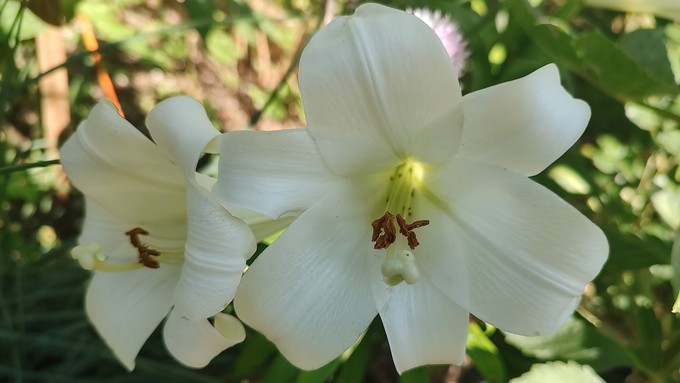
Make the most of your irrigation; Green Acres offers free workshops

What month is this? These Easter lilies bloomed in July in Sacramento. Like all lilies, they appreciate consistent irrigation. Debbie Arrington
July is Sacramento’s hottest month of the year – and when we use the most outdoor irrigation.
Are you getting the most out of your sprinklers or drip system?
Now is a good time to do a quick check-up of your irrigation system – if you haven’t already. Walk around your landscape while the system is running and take note of which heads are doing what – are they blocked by foliage, gushing geysers into the air or not working at all?
With drip systems, hunt for dry spots where emitters may be blocked. Plunge a moisture meter or 6-inch screwdriver into the soil; if it’s too dry, there may be an issue.
One easy fix that will save water: Upgrade to high-efficiency rotary sprinkler heads. These rotating nozzles put out streams of heavy droplets that allow for better coverage and less evaporation than traditional spray heads. They can be installed with a screwdriver. Rebates may be available; check www.bewatersmart.info.
Just make sure to change all the heads on an irrigation station. A mix of heads makes for uneven distribution – dry spots and wet spots – and an unhealthy landscape.
Want to learn more about irrigation? Get answers to your watering questions? Check out these free workshops Saturday at all locations of Green Acres Nursery & Supply.
At 10 a.m. July 8, every Green Acres will host “Irrigation 101: Water Efficiency,” an information-packed seminar that simplifies this essential topic. Green Acres irrigation experts will walk participants through the steps of retrofitting sprinklers and upgrading technology. They’ll also answer questions about specific circumstances. Green Acres stocks many of these irrigation components and staff will help participants pick out the right parts for their irrigation needs.
Green Acres nurseries are located in Sacramento, Auburn, Citrus Heights, Elk Grove, Folsom, Rocklin and Roseville.
For more details and directions: https://idiggreenacres.com/.
Comments
0 comments have been posted.Sacramento Digs Gardening to your inbox.
Food in My Back Yard Series
May 6: Maintain soil moisture with mulch for garden success
April 29: What's (already) wrong with my tomato plants?
April 22: Should you stock up on fertilizer? (Yes!)
April 15: Grow culinary herbs in containers
April 8: When to plant summer vegetables
April 1: Don't be fooled by these garden myths
March 25: Fertilizer tips: How to 'feed' your vegetables for healthy growth
March 18: Time to give vegetable seedlings some more space
March 11: Ways to win the fight against weeds
March 4: Potatoes from the garden
Feb. 25: Plant a fruit tree now -- for later
Feb. 18: How to squeeze more food into less space
Feb. 11: When to plant? Consider staggering your transplants
Feb. 4: Starting in seed starting
Sites We Like
Garden Checklist for week of May 11
Make the most of the lower temperatures early in the week. We’ll be back in the 80s by Thursday.
* Plant, plant, plant! It’s prime planting season in the Sacramento area. Time to set out those tomato transplants along with peppers and eggplants. Pinch off any flowers on new transplants to make them concentrate on establishing roots instead of setting premature fruit.
* Direct-seed melons, cucumbers, summer squash, corn, radishes, pumpkins and annual herbs such as basil.
* Harvest cabbage, lettuce, peas and green onions.
* In the flower garden, direct-seed sunflowers, cosmos, salvia, zinnias, marigolds, celosia and asters. (You also can transplant seedlings for many of the same flowers.)
* Plant dahlia tubers.
* Transplant petunias, marigolds and perennial flowers such as astilbe, columbine, coneflowers, coreopsis, dahlias, rudbeckia and verbena.
* Keep an eye out for slugs, snails, earwigs and aphids that want to dine on tender new growth.
* Feed summer bloomers with a balanced fertilizer.
* For continued bloom, cut off spent flowers on roses as well as other flowering plants.
* Add mulch to the garden to maintain moisture. Mulch also cuts down on weeds. But don’t let it mound around the stems or trunks of trees or shrubs. Leave about a 6-inch-to-1-foot circle to avoid crown rot or other problems.
* Remember to weed! Pull those nasties before they set seed.
* Water early in the day and keep seedlings evenly moist.